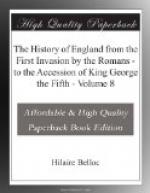The publication of these important documents imposed[a] on Charles the necessity of vindicating his conduct to his Protestant subjects; a task of no very easy execution, had he not availed himself of the permission which he had formerly extorted from the attachment of Glamorgan. In an additional message to the two houses, he protested that he had never given to that nobleman any other commission than to enlist soldiers, nor authorized him to treat on any subject without the privity of the lord lieutenant; that he disavowed all his proceedings and engagements with the Catholics of Ireland; and that he had ordered the privy council in Dublin to proceed against him for his presumption according to law.[2] That council, however,[b] or at least the lord lieutenant, was in possession of a document unknown to the parliament, a copy of the warrant by which Charles had engaged to confirm whatever Glamorgan should promise in the royal name. On this account, in his answer to Ormond, he was compelled to shift his ground, and to assert that he had no recollection of any such warrant; that it was indeed possible he might have furnished the earl with some credential to the Irish Catholics; but that if he did, it was only with an understanding that it should not be employed without the knowledge and the approbation
[Footnote 1: Clarendon Papers, ii. 213. Journals, viii. 103, 125. Commons’ iv. Jan. 16, 26. Charles’s works, 551. Baillie, ii. 185.]
[Footnote 2: Journals, viii. 132. Charles’s Works, 555.]
[Sidenote a: A.D. 1646. Jan. 29.] [Sidenote b: A.D. 1646. Jan. 31.]
of the lord lieutenant. Whoever considers the evasive tendency of these answers, will find in them abundant proof of Glamorgan’s pretentions.[1]
That nobleman had already recovered his liberty. To prepare against subsequent contingencies, and to leave the king what he termed “a starting-hole,” he had been careful to subjoin to his treaty a secret article called a defeasance, stipulating that the sovereign should be no further bound than he himself might think proper, after he had witnessed the efforts of the Catholics in his favour; but that Glamorgan should conceal this release from the royal knowledge till he had made every exertion in his power to procure the execution of the treaty.[2] This extraordinary instrument he now produced in his own vindication: the council ordered him to be discharged upon bail for his appearance when it might be required; and he[a] hastened under the approbation of the lord lieutenant, to resume his negotiation with the Catholics at Kilkenny. He found the general assembly divided into two parties. The clergy, with their adherents, opposed the adoption of any peace in which the establishment of the Catholic worship was not openly recognized; and their arguments were strengthened by the recent imprisonment of Glamorgan, and the secret influence of the papal nuncio Rinuccini, archbishop and prince of Fermo, who had lately landed in Ireland. On the other hand, the members of the council and the lords and gentlemen of the pale strenuously recommended the adoption of one of the two expedients which have




